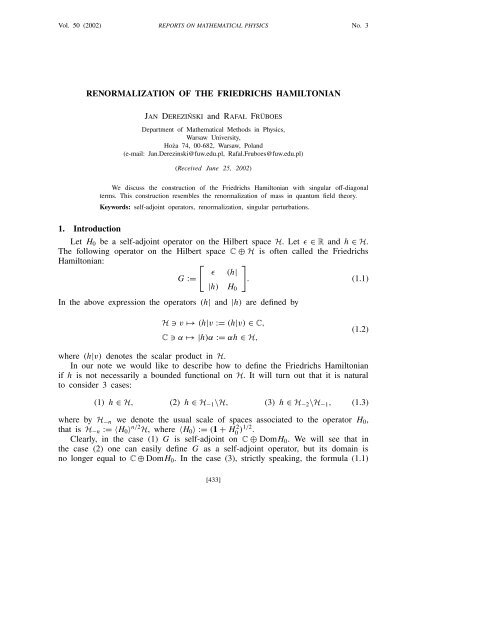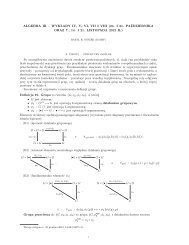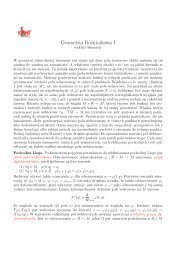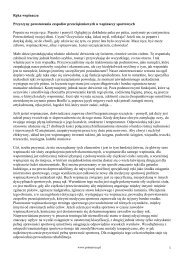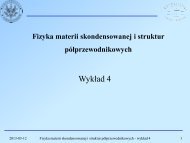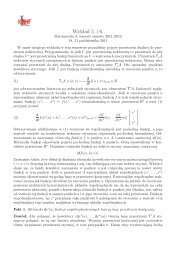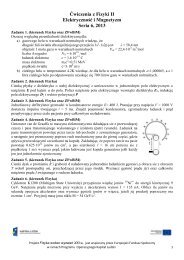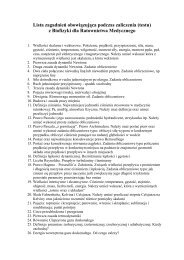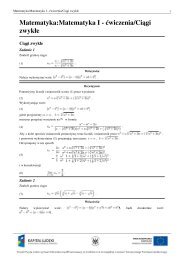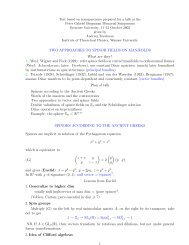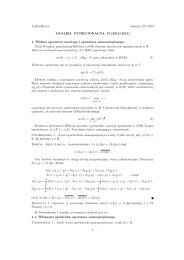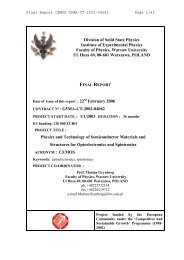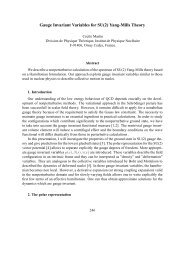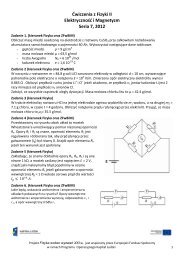RENORMALIZATION OF THE FRIEDRICHS HAMILTONIAN 1 ...
RENORMALIZATION OF THE FRIEDRICHS HAMILTONIAN 1 ...
RENORMALIZATION OF THE FRIEDRICHS HAMILTONIAN 1 ...
You also want an ePaper? Increase the reach of your titles
YUMPU automatically turns print PDFs into web optimized ePapers that Google loves.
Vol. 50 (2002) REPORTS ON MA<strong>THE</strong>MATICAL PHYSICS No. 3<br />
<strong>RENORMALIZATION</strong> <strong>OF</strong> <strong>THE</strong> <strong>FRIEDRICHS</strong> <strong>HAMILTONIAN</strong><br />
JAN DEREZIŃSKI and RAFAŁ FRÜBOES<br />
Department of Mathematical Methods in Physics,<br />
Warsaw University,<br />
Hoża 74, 00-682, Warsaw, Poland<br />
(e-mail: Jan.Derezinski@fuw.edu.pl, Rafal.Fruboes@fuw.edu.pl)<br />
(Received June 25, 2002)<br />
We discuss the construction of the Friedrichs Hamiltonian with singular off-diagonal<br />
terms. This construction resembles the renormalization of mass in quantum field theory.<br />
Keywords: self-adjoint operators, renormalization, singular perturbations.<br />
1. Introduction<br />
Let H 0 be a self-adjoint operator on the Hilbert space H. Let ɛ ∈ R and h ∈ H.<br />
The following operator on the Hilbert space C ⊕ H is often called the Friedrichs<br />
Hamiltonian:<br />
[ ]<br />
ɛ (h|<br />
G :=<br />
. (1.1)<br />
|h) H 0<br />
In the above expression the operators (h| and |h) are defined by<br />
H ∋ v ↦→ (h|v := (h|v) ∈ C,<br />
C ∋ α ↦→ |h)α := αh ∈ H,<br />
(1.2)<br />
where (h|v) denotes the scalar product in H.<br />
In our note we would like to describe how to define the Friedrichs Hamiltonian<br />
if h is not necessarily a bounded functional on H. It will turn out that it is natural<br />
to consider 3 cases:<br />
(1) h ∈ H, (2) h ∈ H −1 \H, (3) h ∈ H −2 \H −1 , (1.3)<br />
where by H −n we denote the usual scale of spaces associated to the operator H 0 ,<br />
that is H −n := 〈H 0 〉 n/2 H, where 〈H 0 〉 := (1 + H 2 0 )1/2 .<br />
Clearly, in the case (1) G is self-adjoint on C ⊕ DomH 0 . We will see that in<br />
the case (2) one can easily define G as a self-adjoint operator, but its domain is<br />
no longer equal to C ⊕ DomH 0 . In the case (3), strictly speaking, the formula (1.1)<br />
[433]
434 J. DEREZIŃSKI and R. FRÜBOES<br />
does not make sense. Nevertheless, it is possible to define a renormalized Friedrichs<br />
Hamiltonian. To do this one needs to renormalize the parameter ɛ. This procedure<br />
resembles the renormalization of mass in quantum field theory.<br />
Friedrichs Hamiltonian appears in various guises in the physics and mathematics<br />
literature. For instance, the Wigner–Weisskopf model, the Jaymes–Cummings model<br />
and one of the sectors of the Lee model are essentially equivalent to the Friedrichs<br />
Hamiltonian [10]. It was studied by Friedrichs in his well-known book [5]. (Note,<br />
however, that the name “Friedrichs Hamiltonian” is sometimes used to denote operators<br />
different from (1.1)).<br />
Basic idea of the renormalization of the Friedrichs Hamiltonian seems to belong<br />
to the folklore of quantum physics. For instance, it was mentioned in [5]. Nevertheless,<br />
we are not aware of a rigorous exposition of this instructive toy model in the<br />
literature.<br />
A phenomenon similar to the renormalization of the Friedrichs Hamiltonian occurs<br />
in the case of rank one perturbations. To be more precise, let λ ∈ R and<br />
consider the operator of the form H := H 0 + λ|h)(h|. One of the first mathematical<br />
treatments of those operators appeared in [2, 4], therefore, to fix terminology, we<br />
will call H the Aronszajn–Donoghue Hamiltonian. It turns out that one can make<br />
sense of the Aronszajn–Donoghue Hamiltonian even if h ∈ H −2 by an appropriate<br />
renormalization of the coupling constant λ. This fact was observed by many authors,<br />
among them let us mention Berezin and Faddeev [3] in the case of a delta-like perturbation<br />
of the 3-dimensional Laplacian and Kiselev and Simon [7] in the case of<br />
an abstract semibounded operator H 0 . The renormalization of Aronszajn–Donoghue<br />
Hamiltonians is in fact reminiscent of the charge renormalization in QFT. For comparison<br />
with the theory of Friedrichs Hamiltonians, in Section 4 we briefly sketch<br />
the theory of Aronszajn–Donoghue Hamiltonians (without assuming H 0 to be semibounded).<br />
We will see that the renormalization of Friedrichs Hamiltonians resembles that<br />
of Aronszajn–Donoghue Hamiltonians. There is however a difference: in the case<br />
of Friedrichs Hamiltonians one applies what can be called the additive renormalization,<br />
whereas in the case of Aronszajn–Donoghue Hamiltonians the multiplicative<br />
renormalization is performed.<br />
2. Renormalization<br />
Let us first consider the case h ∈ H. As we have said earlier, the operator G<br />
with DomG = C ⊕ DomH 0 is self-adjoint. It is well known that the resolvent of G<br />
can be computed exactly. In fact, for z ∉ spH 0 define the analytic function<br />
g(z) := ɛ + (h|(z 1 H − H 0 ) −1 h), (2.1)<br />
(spH 0 denotes the spectrum of H 0 ). Then for z ∈ := {z ∈ C\spH 0 : g(z) − z ≠ 0}<br />
the resolvent Q(z) := (z 1 C⊕H − G) −1 is given by
Q(z) =<br />
<strong>RENORMALIZATION</strong> <strong>OF</strong> <strong>THE</strong> <strong>FRIEDRICHS</strong> <strong>HAMILTONIAN</strong> 435<br />
[<br />
0 0<br />
0 (z 1 H − H 0 ) −1 ]<br />
⎡<br />
( ) −1<br />
+ z − g(z) ⎣<br />
⎤<br />
1 C (h|(z 1 H − H 0 ) −1<br />
⎦ . (2.2)<br />
(z 1 H − H 0 ) −1 |h) (z 1 H − H 0 ) −1 |h)(h|(z 1 H − H 0 ) −1<br />
In what follows we will usually omit H, C ⊕ H, etc. from 1 H , 1 C⊕H . Now let<br />
us describe how to define G for more general h:<br />
<strong>THE</strong>OREM 2.1. Assume that:<br />
(A) h ∈ H −1 , ɛ ∈ R and let Q(z) be given by (2.2) with g(z) defined by (2.1),<br />
or<br />
(B) h ∈ H −2 , γ ∈ R and let Q(z) be given by (2.2) with g(z) defined by<br />
g(z) := γ + ( h|((z − H 0 ) −1 + H 0 (1 + H0 2)−1 )h )<br />
(<br />
)<br />
i − z<br />
= γ + h|(<br />
2(z − H 0 )(i − H 0 ) − i + z<br />
2(z − H 0 )(−i − H 0 ) )h (2.3)<br />
.<br />
Then for all z ∈ :<br />
(i)<br />
Q(z) is a bounded operator which fulfills the first resolvent formula (in the<br />
terminology of [6], Q(z) is a pseudoresolvent).<br />
(ii) KerQ(z) = {0}.<br />
(iii) RanQ(z) is dense in C ⊕ H.<br />
(iv) Q(z) ∗ = Q(¯z).<br />
Therefore, by [6], there exists a unique densely defined self-adjoint operator G such<br />
that Q(z) = (z − G) −1 . More precisely, for any z 0 ∈ , DomG = RanQ(z 0 ), and if<br />
ϕ ∈ RanQ(z 0 ) and Q(z 0 )ψ = ϕ, then<br />
Gϕ := −ψ + z 0 Q(z 0 )ψ.<br />
Proof : Let z ∈ . It is obvious that Q(z) is bounded and satisfies (iv). We<br />
easily see that both in the case (A) and (B) the function g(z) satisfies<br />
g(z 1 ) − g(z 2 ) = −(z 1 − z 2 )(h|(z 1 − H 0 ) −1 (z 2 − H 0 ) −1 |h). (2.4)<br />
Direct computations using (2.4) show the first resolvent formula.<br />
Let (α, f ) ∈ C ⊕ H be such that (α, f ) ∈ KerQ(z). Then<br />
0 = (z − g(z)) −1( )<br />
α + (h|(z − H 0 ) −1 f ) , (2.5)<br />
)<br />
0 = (z − H 0 ) −1 f + (z − H 0 ) −1 h(z − g(z))<br />
(α −1 + (h|(z − H 0 ) −1 f ) . (2.6)<br />
Inserting (2.5) into (2.6) we get 0 = (z − H 0 ) −1 f and hence f = 0. Now (2.5)<br />
implies α = 0, so KerQ(z) = {0}.<br />
Using (ii) and (iv) we get (RanQ(z)) ⊥ = KerQ(z) ∗ = KerQ(¯z) = {0}. Hence<br />
(iii) holds.<br />
✷
436 J. DEREZIŃSKI and R. FRÜBOES<br />
3. Cut-off renormalization<br />
Let h ∈ H −2<br />
and γ ∈ R. Let us impose a cut-off on h. For k ∈ N we define<br />
h k := 1 [−k,k] (H 0 ) h, (3.1)<br />
where 1 [−k,k] (H 0 ) is the spectral projection for H 0 associated with the interval<br />
[−k, k] ⊂ R. Note that h k ∈ H and hence both (h k | and |h k ) are well-defined<br />
bounded operators. Set<br />
ɛ k := γ + (h k |H 0 (1 + H 2 0 )−1 h k ).<br />
For all k ∈ N, the cut-off Friedrichs Hamiltonian<br />
[ ]<br />
ɛk (h k |<br />
G k :=<br />
|h k ) H 0<br />
is well defined and we can compute its resolvent Q k (z) := (z 1 C⊕H − G k ) −1 :<br />
[ ]<br />
0 0<br />
Q k (z) =<br />
0 (z 1 H − H 0 ) −1<br />
⎡<br />
⎤<br />
( ) −1 1 C (h k |(z 1 H − H 0 ) −1<br />
+ z−g k (z) ⎣<br />
⎦ , (3.2)<br />
(z 1 H − H 0 ) −1 |h k ) (z 1 H − H 0 ) −1 |h k )(h k |(z 1 H − H 0 ) −1<br />
where<br />
g k (z) := ɛ k + (h k |(z − H 0 ) −1 h k ). (3.3)<br />
Note that ɛ k is chosen in such a way that the following renormalization condition<br />
is satisfied: 1 2 (g k(i) + g k (−i)) = γ . Let us also mention that if H 0 is bounded from<br />
below, then lim k→∞ ɛ k = ∞.<br />
<strong>THE</strong>OREM 3.1. Assume that h ∈ H −2 . Then lim<br />
k→∞ Q k(z) = Q(z), where Q(z) is<br />
given by (2.2) and g(z) is given by (2.3).<br />
Proof : The proof is obvious if we note that lim ‖(z−H 0 ) −1 h−(z−H 0 ) −1 h k ‖ = 0<br />
k→∞<br />
and lim g k(z) = g(z).<br />
✷<br />
k→∞<br />
Thus the cut-off Friedrichs Hamiltonian is norm resolvent convergent to the<br />
renormalized Friedrichs Hamiltonian.<br />
4. Renormalization of the Aronszajn–Donoghue Hamiltonian<br />
In this section we briefly sketch the renormalization procedure for Aronszajn–<br />
Donoghue Hamiltonians (see [1, 3, 7]).
<strong>RENORMALIZATION</strong> <strong>OF</strong> <strong>THE</strong> <strong>FRIEDRICHS</strong> <strong>HAMILTONIAN</strong> 437<br />
Let H 0 be again a self-adjoint operator on H, h ∈ H and λ ∈ R. As before we<br />
start with the case h ∈ H. Note that according to (1.2), |h)(h| equals the orthogonal<br />
projection onto h times ‖h‖ 2 . Thus<br />
H := H 0 + λ|h)(h| (4.1)<br />
is a rank one perturbation of H 0 . We will call (4.1) the Aronszajn–Donoghue<br />
Hamiltonian. Clearly, H is self-adjoint on DomH 0 . We can compute its resolvent.<br />
In fact, for z ∉ spH 0 we define an analytic function<br />
g(z) := −λ −1 + (h|(z − H 0 ) −1 h). (4.2)<br />
Then for z ∈ := {z ∈ C\spH 0 : g(z) ≠ 0} and λ ≠ 0, the resolvent of the operator<br />
H is given by Krein’s formula<br />
R(z) = (z − H 0 ) −1 − g(z) −1 (z − H 0 ) −1 |h)(h|(z − H 0 ) −1 . (4.3)<br />
For λ = 0, we set = C\spH 0<br />
and clearly<br />
R(z) = (z − H 0 ) −1 . (4.4)<br />
<strong>THE</strong>OREM 4.1. Assume that:<br />
(A) h ∈ H −1 , λ ∈ R ∪ {∞} and let R(z) be given by (4.4) or (4.3) with g(z) given<br />
by (4.2),<br />
or<br />
(B) h ∈ H −2 , γ ∈ R and let R(z) be given by (4.3) with g(z) given by<br />
g(z) := γ + ( h|((z − H 0 ) −1 + H 0 (1 + H 2 0 )−1 )h ) .<br />
Then, for all z ∈ ,<br />
(i) R(z) is a bounded operator which fulfills the first resolvent formula.<br />
(ii) KerR(z) = {0}, unless h ∈ H and λ = ∞.<br />
(iii) RanR(z) is dense in H, unless h ∈ H and λ = ∞.<br />
(iv) R(z) ∗ = R(¯z).<br />
Hence, except for the case h ∈ H, λ = ∞, there exists a unique densely defined<br />
self-adjoint operator H such that R(z) is the resolvent of H .<br />
Another way to define H for the case h ∈ H −2 is the cut-off method. For all<br />
k ∈ N we define h k as in (3.1) and fix the running coupling constant by<br />
and set the cut-off Hamiltonian to be<br />
Then the resolvent for H k<br />
−λ −1<br />
k<br />
:= γ + (h k |H 0 (1 + H 2 0 )−1 h k ),<br />
H k := H 0 + λ k |h k )(h k |. (4.5)<br />
is given by<br />
R k (z) = (z − H 0 ) −1 + g k (z) −1 (z − H 0 ) −1 |h k )(h k |(z − H 0 ) −1 , (4.6)
438 J. DEREZIŃSKI and R. FRÜBOES<br />
where<br />
g k (z) := −λ −1<br />
k<br />
+ ( h k |(z − H 0 ) −1 h k<br />
)<br />
. (4.7)<br />
Note that λ k is chosen in such a way that the renormalization condition 1 2 (g k(i) +<br />
g k (−i)) = γ holds. It is easy to see that if H 0 is bounded from below, then<br />
lim k→∞ λ k = 0. Again, the cut-off Hamiltonian converges to the renormalized Hamiltonian.<br />
<strong>THE</strong>OREM<br />
4.2. Assume that h ∈ H −2 . Then lim<br />
k→∞ R k(z) = R(z).<br />
REFERENCES<br />
[1] S. Albeverio and P. Kurasov: Singular Perturbations of Differential Operators, Cambridge Univ. Press,<br />
Cambridge 2000.<br />
[2] N. Aronszajn: On a problem of Weyl in the theory of singular Sturm-Liouville equations, Am. J. Math.<br />
79 (1957), 597–610.<br />
[3] F. A. Berezin and L. D. Faddeev: Remark on the Schrödinger equation with singular potential, Dokl. Akad.<br />
Nauk. SSSR 137 (1961), 1011–1014.<br />
[4] W. Donoghue: On the perturbation of spectra, Commun. Pure App. Math. 18 (1965), 559–579.<br />
[5] K. O. Friedrichs: Perturbation of Spectra in Hilbert Space, American Mathematical Society, Providence<br />
1965.<br />
[6] T. Kato: Perturbation Theory for Linear Operators, second edition, Springer, Berlin 1976.<br />
[7] A. Kiselev and B. Simon: Rank one perturbations with infinitesimal coupling, J. Funct. Anal. 130(2)<br />
(1995), 345–356.<br />
[8] M. Reed and B. Simon: Methods of Modern Mathematical Physics, I. Functional Analysis, London,<br />
Academic Press 1980.<br />
[9] M. Reed and B. Simon: Methods of Modern Mathematical Physics, II. Fourier Analysis, Self-Adjointness,<br />
London, Academic Press 1975.<br />
[10] S. S. Schweber: An Introduction to Relativistic Quantum Field Theory, Harper and Row, 1962.<br />
[11] Yu. Shondin: Perturbation of differential operators on high-codimension manifold and the extension theory<br />
for symmetric linear relations in an indefinite metric space, Teoret. Mat. Fiz. 92 (1992), 466–472.<br />
[12] Yu. Shondin: Quantum mechanical models in R n connected with extensions of the energy operator in a<br />
Pontryagin space, Teoret. Mat. Fiz. 74 (1988), 331–344.


